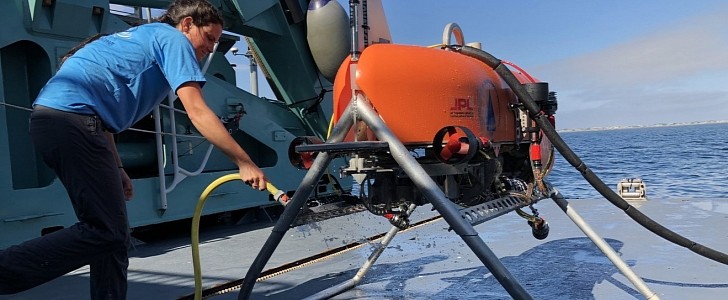Ever wondered about the unexplored depths of the ocean? Well, scientists are now one step closer to unraveling some of the mysteries of this unknown territory with the help of NASA technology.
Just a few days ago, Okeanos Explorer, a National Oceanic and Atmospheric Administration (NOAA) ship, has embarked on a 2-week expedition of the Atlantic Ocean. Its objective, according to NASA’s Jet Propulsion Laboratory (JPL), is to test a new underwater robot that promises to revolutionize ocean exploration.
Orpheus, the submersible robot, has something in common with the Perseverance Mars Rover and the Mars Ingenuity Helicopter: a technology developed by JPL. A version of the “vision-based navigation” that helped map out the Martian surface is now used to get a clearer layout of the unexplored ocean floor.
At 550 lbs (250 kg), Orpheus is actually lighter than similarly sized robots while also being rugged enough for deep-sea exploration, as well as easy to operate. It was designed by Woods Hole Oceanographic Institution (WHOI) together with JPL as an alternative to the heavy equipment that is usually required for this type of exploration. For now, it will test its cameras, lights, and software in shallower waters, but it’s ultimately designed to go as far as the hadal zone, which is deeper than 20,000 ft (6,000 meters).
While Orpheus will be moving across the seafloor, the “visual-inertial odometry” (xVIO) technology will identify objects along the way and use them to create a 3D navigation map, which will also be stored in memory. This allows the robot to recognize the area when it returns and to continue from there, going further and further. The plan is to eventually develop a whole team of submersible robots, which will share their maps and use them for cross-reference.
As fascinating as the depths of the ocean are, what’s even more exciting about this new technology is that it might also be used to explore oceans that aren’t on our planet, such as the subsurface ocean on Jupiter’s moon, Europa. In the end, there is no separation, and it all comes full circle.
Orpheus, the submersible robot, has something in common with the Perseverance Mars Rover and the Mars Ingenuity Helicopter: a technology developed by JPL. A version of the “vision-based navigation” that helped map out the Martian surface is now used to get a clearer layout of the unexplored ocean floor.
At 550 lbs (250 kg), Orpheus is actually lighter than similarly sized robots while also being rugged enough for deep-sea exploration, as well as easy to operate. It was designed by Woods Hole Oceanographic Institution (WHOI) together with JPL as an alternative to the heavy equipment that is usually required for this type of exploration. For now, it will test its cameras, lights, and software in shallower waters, but it’s ultimately designed to go as far as the hadal zone, which is deeper than 20,000 ft (6,000 meters).
While Orpheus will be moving across the seafloor, the “visual-inertial odometry” (xVIO) technology will identify objects along the way and use them to create a 3D navigation map, which will also be stored in memory. This allows the robot to recognize the area when it returns and to continue from there, going further and further. The plan is to eventually develop a whole team of submersible robots, which will share their maps and use them for cross-reference.
As fascinating as the depths of the ocean are, what’s even more exciting about this new technology is that it might also be used to explore oceans that aren’t on our planet, such as the subsurface ocean on Jupiter’s moon, Europa. In the end, there is no separation, and it all comes full circle.





